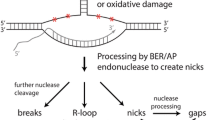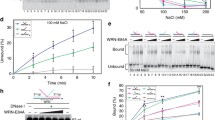Abstract
Repetitive DNA sequences, interspersed throughout the human genome, are capable of forming a wide variety of unusual DNA structures with simple and complex loopfolding patterns. The hairpin formed by the fragile X repeat, (CCG)n, and the bipartite triplex formed by the Friedreich's ataxia repeat, (GAA)n/(TTC)n, show simple loopfolding. On the other hand, the doubly folded hairpin formed by the human centromeric repeat, (AATGG)n, the hairpin G‐quartet formed by (TTAGGG)n at the 3′ telomere overhang, and the hairpin G‐quartet, and hairpin C+•C paired i‐motif formed by the insulin minisatellite,
show multiple and complex loopfolding. We have performed high resolution nuclear magnetic resonance (NMR) spectroscopy and in vitro replication to show that unique base-pairing and loopfolding render stability to these unusual structures under physiological conditions. The formation of such stable structures offers a mechanism of unwinding which is advantageous during transcription. For example, the formation of the hairpin G-quartet, and hairpin C2+•C paired i-motif upstream of the insulin gene may facilitate transcription. These unusual DNA structures also provide unique ‘protein recognition motifs’ quite different from a Watson—Crick double helix. For example, the hairpin G-quartet formed by (TTAGGG)n at the 3′ telomere overhang is specifically recognized and stabilized by the human repair protein, Ku70/Ku80 hetero-dimer, which may be important in the stability of the telomere. However, the formation of the same unusual DNA structures during replication is likely to cause instability in the lengths of the DNA repeats. If the altered (generally expanded) length enhances the probability of the unusual structure during the next cycle of replication, it further increases the instability of the repeat causing a ‘dynamic mutation’. In fact, NMR and in vitro replication studies show that the longer the repeat length the higher is the probability of hairpin formation by the fragile X repeat, (CCG)n. In addition, the hairpin of the fragile X repeat, upstream of the FMR-1 gene, is more susceptible to CpG methylation than its duplex thereby leading to methyl-directed suppression of transcription. Thus, the selective advantage of the unusual structures formed by the DNA repeats in the regulation of gene expression may be offset by the genomic instability caused by the same structures during replication. The repeat number is a critical parameter that helps maintain a balance between the advantage gained from an unusual structure during gene expression and the disadvantage posed by the same structure during replication.
Similar content being viewed by others
References
Moyzis R.K., Torney D.C., Meyne J., Buckingham J.M., Wu J.-R., Burks C., Sirotkin K.M. and Goad W.B.: The distribution of interspersed repetitive DNA sequences in the human genome, Genomics 4 (1989): 273–289.
Stallings R.L., Torney D.C., Hildebrand C.E., Longmire J.L., Deaven L.L., Jett J. H., Doggett N.A. and Moyzis R.K.: Physical mapping of human chromosomes by repetitive sequence finger printing, Proc. Natl. Acad. Sci. USA 87 (1990): 6218–6222.
Orgel L.E, Crick F.H. and Sapienza C.: Selfish DNA. Nature, 288 (1980): 645–646.
Lee C., Wevrick R., Fisher R.B., Ferguson-Smith M.A. and Lin C.C.: Human centromeric DNAs, Human Genet. 100 (1997): 291–304.
Wright W.E., Tesmer V.M., Huffman K.E., Levene S.D. and Shay J.W.: Normal human chromosomes have long G-rich telomeric overhangs at one end, Genes Develop. 11 (1997): 2801–2809.
Moyzis R.K.: The human telomere, Structure Methods 1 (1990): 61–67.
Caskey C.T., Pizzuti A., Fu Y-H., Fenwick R.G. and Nelson D.L.: Triplet repeat mutations in human disease, Science 256 (1992): 784–789.
Krontiris T.G.: Minisatellites and human disease, Science 269 (1995): 1682–1683.
Wells R.D.: Molecular basis of genetic instability of triplet repeats, J. Biol. Chem. 271 (1996): 2875–2878.
McMurray C.T.: Mechanisms of DNA expansion, Chromosoma 4 (1995): 2–13.
Pieretti M., Zhang F., Fu Y.-H., Warren S.T., Oostra B.A., Caskey C.T. and Nelson D.L.: Absence of expression of the FMR-1 gene in fragile X syndrome, Cell 66 (1991): 817–822.
Mahadevan M., Tsilfidis C., Sabourin L., Shutler G., Amemiya C., Jansen G., Neville C., Marang M., Barcelo J., O'Hoy K., Leblond S., Earle-Macdonald J., De Jong P.J., Wieringa B. and Korneluk R.G.: Myotonic dystrophy mutation: an unstable CTG repeat in the 3′ untranslated region of the gene. Science 255 (1992): 1253–1255.
Campuzano V., Montermini L, Molto M.D., Pianese L., Cossee M., Cavalcanti F., Monros E., Rodius F., Duclos F., Monticelli A., Zara F., Canizres J., Koutnikova H., Bidichandani S.I., Gellera C., Brice A., Trouillas P., De Michele G., Filla A., De Fruots R., Palau F., Patel P.I., Di Donato S., Mandel J-L., Cocozza S., Koenig M. and Pandolfo M.: Friedreich's ataxia: autosomal recessive disease caused by an intronic GAA triplet repeat expansion, Science 271 (1996): 1423–1427.
Kennedy G.C., German M.S. and Rutter W.J.: The minisatellite in the diabetes susceptibility locus IDDM2 regulates insulin transcription, Nature Genet. 9 (1995): 293–298.
Sen D. and Gilbert W.: Guanine quartet structures, Meth. Enzymol. 211 (1992): 191–199.
Grady D.L., Ratliff R.L., Robinson D.L., McCanlies D.C., Meyne J. and Moyzis R.K.: Highly conserved repetitive DNA sequences are present at human centromeres, Proc. Natl. Acad. Sci. USA 89 (1992): 1695–1699.
Zawel L. and Reinber D.: Common themes in assembly and function of eukaryotic transcription complexes, Annu. Rev. Biochem. 64 (1995): 533–561.
Mariappan S.V.S., Chen X., Catasti P., Chen X., Ratliff R., Moyzis R.K., Bradbury E.M. and Gupta G.: Structural studies on the unstable triplet repeats. In: Wells R.D. and Warren S.T. (eds), Genetic Instabilities and Hereditary Neurological Disorder. Academic Press, New York, 1998, pp. 515–554.
Catasti P., Chen X., Bradbury E.M. and Gupta, G. In: Sarma R.H. and Sarma M.H. (eds), Structure, Motion, Interaction, and Expression of Biological Macromolecules. Adenine Press, New York, 1998, pp. 647–673.
Chen X., Mariappan S.V.S., Ratlif R., Moyzis R.K., Bradbury E.M. and Gupta G.: Hairpin induced slippage and hypermethylation of the fragile X DNA triplets, J. Biomol. Str. Dyn. 15 (1998): 745–756.
Gacy M.A., Goellner G.M., Spiro C., Chen X., Gupta G., Bradbury E.M., Dyer R.B., Mikesell M.J., Yao J.Z., Johnson A.J., Richter A., Melancon S., McMurray C.T.: GAA instability in Friedreich's ataxia shares a common, DNA-directed and intra-allelic mechanism with other trinucleotide diseases. Cell (molecular) 1 (1997): 583–593.
Catasti P., Chen X., Moyzis R.K., Bradbury E.M. and Gupta G.: Structure-function correlations of the insulin-linked polymorphic region, J. Mol. Biol. 264 (1996): 534–545.
Catasti P., Chen X., Moyzis R.K., Bradbury E.M. and Gupta G.: Cytosine-rich strands of the insulin minisatellite adopt hairpins with intercalated cytosine+•cytosine pairs, J. Mol. Biol. 272 (1997): 369–382.
Catasti P., Gupta G., Garcia A.E., Ratliff R., Hong L., Yau P., Moyzis R.K. and Bradbury E.M.: Unusual structures of the tandem repetitive DNA sequences located at human centromeres, Biochem. 33 (1994): 3819–3830.
Bell M.V., Hirst M.C., Nakahori Y., MacKinnon R.N., Roche A., Flint T.J, Jacobs P.A., Tommerup N., Tranebjaerg L., Froster-Iskenius U., Kerr B., Turner G., Lindenbaum R.H., Winter R., Pembrey M., Thibodeau S. and Davies K.E.: Physical mapping across the Fragile X: hypermethylation and clinical expression of the ragile X syndrome, Cell 64 (1991): 861–866.
de Graaf E., Rouillard P., Willems P.J., Smits A.P.T., Rousseau F. and Oostra B.A.: Hotspot for deletions in the CGG repeat region of FMR-1 in fragile X patients, Human Mol. Genet. 4 (1995): 45–49.
Laird C.D.: Proposed mechanism of inheritance and expression of the human Fragile-X syndrome of mental retardation, Genetics 117 (1987): 587–599.
Oberle I., Rousseau F., Heitz D., Kretz C., Devys D., Hanauer, A., Boue J., Bertheas M.F. and Mandel J.L.: Instability of a 550-Base pair DNA segment and abnormal methylatin in Fragile X syndrome, Science 252 (1991): 1097–1102.
Eichler E.E., Holden J.J.A., Popovich B.W., Reiss A.L., Snow K., Thibodeau S.N., Richards C.S., Ward P.A. and Nelson D.L.: Length of uninterrupted CGG repeats determines instability in the FMR-1 gene, Nature Genet. 8 (1994): 88–92.
Chen X., Mariappan S.V.S., Catasti P., Ratliff R., Moyzis R.K., Laayoun A., Smith S.S., Bradbury E.M. and Gupta G.: Hairpins are formed by the single DNA strands of the Fragile X triplet repeats: Structure and biological implications, Proc. Natl. Acad. Sci. USA 92 (1995): 5199–5203.
Mariappan S.V.S., Chen X., Catasti P., Ratliff R., Moyzis R.K., Bradbury E.M. and Gupta G.: Solution structures of the individual single strands of the fragile X DNA triplets (GCC)n-(GGC)n, Nucl. Acids Res. 24 (1996): 784–792.
Mariappan S.V.S., Silks L.P., Bradbury E.M. and Gupta G.: Fragile X DNA triplet repeats, (GCC)n, form hairpins with cytosine+• cytosine mispairs at the CpG sites: isotope-edited NMR spectroscopy on (GCC)n with selective 15N4-labeled cytosines, J. Mol. Biol. 283 (1998): 111–120.
Smith S.S., Kaplan B.E., Sowers L.C. and Newman E.M.: Mechanism of human methyl-directed DNA methyltransferase and the fidelity of cytosine methylation, Proc. Natl. Acad. Sci., USA 89 (1992): 4744–4748.
Klimassauskas S., Kumar S., Roberts R.J. and Cheng X.: Hhal methyltransferase flips its target base out of the DNA helix, Cell 76 (1994): 357–369.
Roberts R.J.: On base flipping, Cell 82 (1995): 639–645.
Anteguera F. and Bird A.: Number of Cp'G island and genes in human and mouse, Proc. Natl. Acad. Sci. USA 90 (1993): 11995–11999.
Bird A.P.: CpG-rich island and the function of DNA methylation, Nature 321 (1986): 209–213.
Boyes J. and Bird A.: Repression of genes by DNA methylation depends on CpG density and promoter strength: evidence for involvement of a methyl-CpG binding protein, EMBO J. 11 (1992): 327–333.
Meehen R.R., Lewis J.D., McKay S., Kleiner E.L. and Bird A.: Identification of a mammalian protein that binds specifically to DNA containing methylated CpGs, Cell 58 (1989): 499–507.
Lewis J.D., Meehan R.R., Henzel W.J., Maurer-Fogy I., Jappesen P., Klein F. and Bird A.: Purification, sequence, and cellular localization of a novel chromosomal protein that binds to methylated DNA, Cell 69 (1992): 905–914.
Mitanchez D., Doiron B., Chen R. and Kahn A.: Glucose-stimulated genes and prospects for gene therapy for type I diabetes. Endo. Rev. 18 (1997): 520–540.
Bell G.I., Karam J.H. and Rutter W.J.: Polymorphic DNA region adjacent to the 5′ end of the human insulin gene, Proc. Natl. Acad. Sci. USA 78 (1981): 5759–5763.
Bell G.I., Selby M.J. and Rutter W.J.: The highly polymorphic region near the human insulin gene is composed of simple tandemly repeating sequences, Nature 295 (1982): 31–35.
Bennett S.T., Lucassen A.M., Gough S.C.L., Powell E.E., Undlien D.E., Pritchard L.E., Merriman M.E., Kawaguchi Y., Dronsfield M.J., Pociot F., Nerup J., Bouzekri N., Cambon-Thomsen A., Rønningen K.S., Barnett A.H., Bain S.C. and Todd J.A.: Susceptibility to human type 1 diabetes at IDDM2 is determined by tandem repeat variation at the insulin gene minisatellite locus, Nature Genet 9 (1995): 284–292.
Hammond-Kosack M.C., Dobrinski B., Lurz R., Docherty K. and Kilpatrick M.W.: The human insulin gene linked polymorphic region exhibits an altered DNA structure, Nucl. Acids Res. 20 (1992): 231–236.
Ramsden D.A. and Gellert M.: Ku protein stimulates DNA end joining by mammalian DNA ligases: a direct role for Ku in repair of DNA double-strand breaks, EMBO J. 17 (1998): 609–614.
Smider V. and Chu G.: The end-joining reaction in V(D)J recombination, Semin. Immunol. 9 (1997): 189–197.
Torrance H., Giffin W., Rodda D.J., Pope L. and Hache R.J.: Sequence-specific binding of Ku autoantigen to single-stranded DNA, J. Biol. Chem. 273 (1998): 20810–20819.
Laroche T., Martin S.G., Gotta M., Gorham H.C., Pryde F.E., Louis E.J. and Gasser S.M.: Mutation of yeast Ku genes disrupts the subnuclear organization of telomeres, Current Biol. 8 (1998): 653–666.
Boulton S.J. and Jackson S.P.: Identification of a Saccharomyces cerevisiae Ku80 homologue: roles in DNA double strand break rejoining and in telomeric maintenance, Nucl. Acids Res. 24 (1996): 4639–4648.
Polotnianka R.M., Li J. and Lustig A.J.: The yeast Ku heterodimer is essential for protection of the telomere against nucleolytic and recombinational activities, Current Biol. 8 (1998): 831–834.
Author information
Authors and Affiliations
Rights and permissions
About this article
Cite this article
Catasti, P., Chen, X., Mariappan, S.S. et al. DNA repeats in the human genome. Genetica 106, 15–36 (1999). https://doi.org/10.1023/A:1003716509180
Issue Date:
DOI: https://doi.org/10.1023/A:1003716509180




